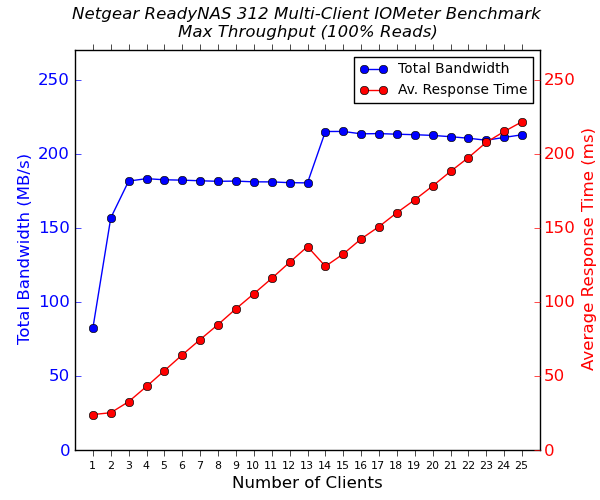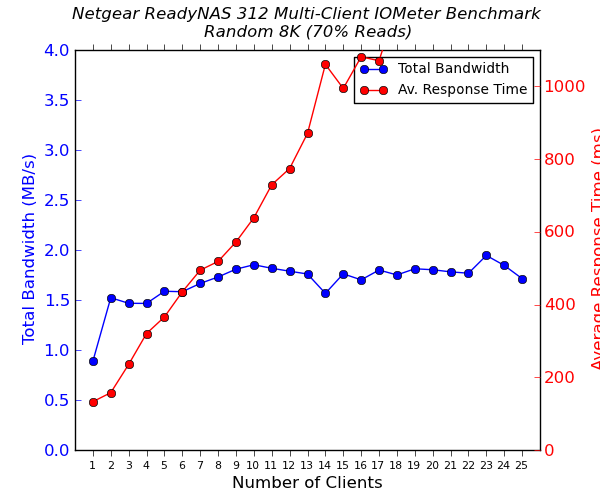Netgear ReadyNAS 312 2-bay SMB / SOHO NAS Review
by Ganesh T S on November 11, 2013 1:00 PM EST- Posted in
- NAS
- IT Computing
- NetGear
- ReadyNAS
Multi-Client Performance - CIFS
We put the ReadyNAS 312 through some IOMeter tests with a CIFS share being accessed from up to 25 VMs simultaneously. The following four graphs show the total available bandwidth and the average response time while being subject to different types of workloads through IOMeter. IOMeter also reports various other metrics of interest such as maximum response time, read and write IOPS, separate read and write bandwidth figures etc. Readers interested in the actual values can refer to our evaluation metrics table available here.




Since this is the first 2-bay unit that we are publishing benchmarks for with the new testing methodology, we don't have graphs for comparison, but, rest assured, upcoming reviews of NAS units with similar number of bays will see comparison graphs available for reference.










18 Comments
View All Comments
mcfrede - Tuesday, November 12, 2013 - link
Final paragraph states the product name as the "ReadyNSA" am I the only one to find that interpretation hilarious? (sorry for being slightly off topic).ganeshts - Tuesday, November 12, 2013 - link
Thanks for noticing that. I fixed the typo now :)jramskov - Tuesday, November 12, 2013 - link
Using btrf is certainly an interesting choice. It would be nice to see an article that explains the advantages of using it instead of ext4.WilliamG - Wednesday, November 13, 2013 - link
Ganesh, Thanks for the review - just wondering if you know if this unit supports Hyper-V virtual machines via SMB ? I have been trying to find out from Netgear for a couple of days but no one can answer me. Windows 2012 R2 Hyper-V allows the use of SMB 3 file shares to host virtual machine files. Can this unit work for me? thanks in advancewarezme - Thursday, November 14, 2013 - link
To be honest I haven't ever really considered a NAS for storage but if I were, a two bay NAS seems a bit useless to me. So you can do RAID 1 and lose half of your storage or do RAID 0 and gain your space but lose any hopes of recovery if one of your drives dies. Wouldn't a 3 bay NAS be the minimum common sense size?bsd228 - Thursday, November 14, 2013 - link
You don't lose half your storage with Raid1. Unreliable storage has limited value. You keep all of your data if one drive fails, which is a lot better than what happens with a failure on any of those 1 disk NAS units out there. If you want capacity or higher performance, then you get a 4+ disk unit, or roll your own.brian.goodman - Saturday, December 7, 2013 - link
When I had a drive failure on the first drive of the RAID pair in my old ReadyNAS Duo, I learned that the second RAID drive was not accessible, since the ReadyNAS Duo boots from an operating system installed on the first drive. ReadyNAS RAIDar could not even see the NAS, so it was not possible to diagnose the problem through the software interface. Instead I had to decode the blinking lights on the ReadyNAS to deduce that the first drive had failed.Is this still the case in the current generation of ReadyNAS products? In fact is that the case with other NAS products?
Losing the ability to use RAIDar and Frontview was a big surprise and I would have expected that to be flagged in product reviews. What happens after drive failure is not something I have seen reported in any NAS review, but it is very important, as most users expect to be able to access the second RAID drive in case of failure.
Could you add failure mode analysis to your reviews, covering whether the NAS is accessible through software for diagnostic purposes (as against physical inspection of a box), and whether the remaining drives of a multi-drive NAS are actually useable one a failure mode occurs?
Thanks,
Brian